Construction Daily Report
-
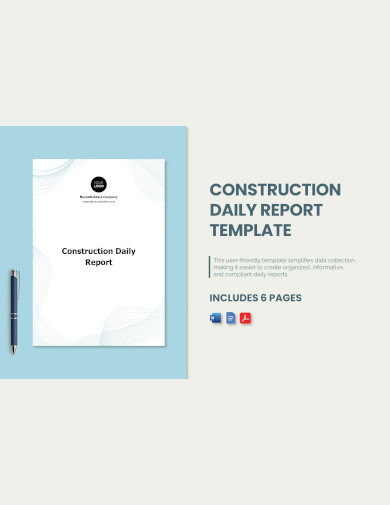
Construction Daily Report Template
download now -

Contractor Construction Daily Report
download now -

Construction Superintendent Daily Report
download now -
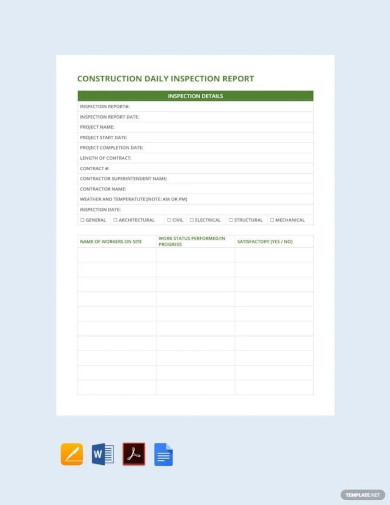
Construction Daily Inspection Report
download now -

Construction Daily Quality Report
download now -
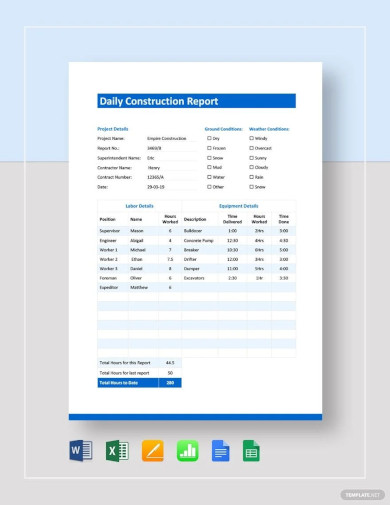
Daily Construction Report Sample
download now -
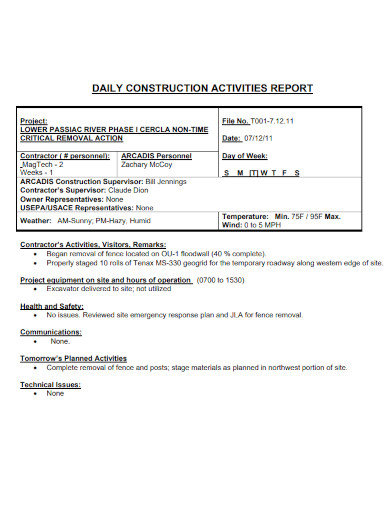
Construction Daily Activities Report
download now -
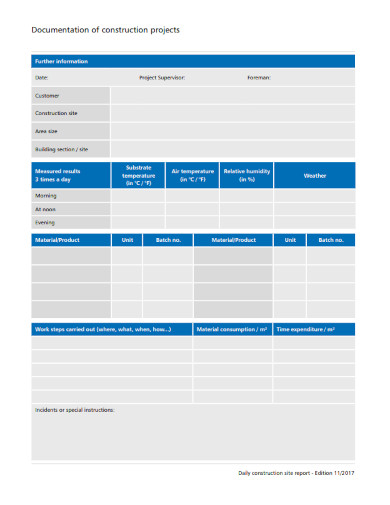
Daily Construction Site Report
download now -
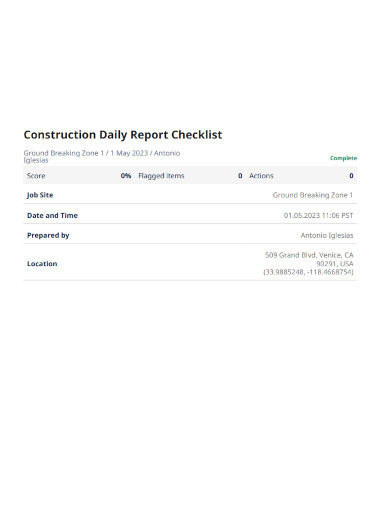
Construction Daily Report Checklist
download now -
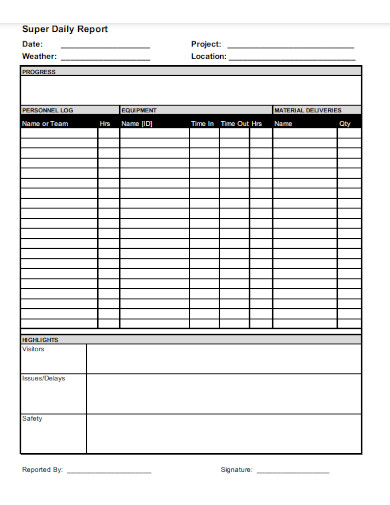
Construction Super Daily Report Template
download now -
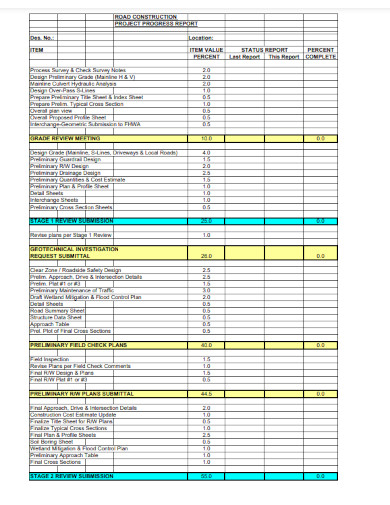
Road Construction Project Progess Report
download now -
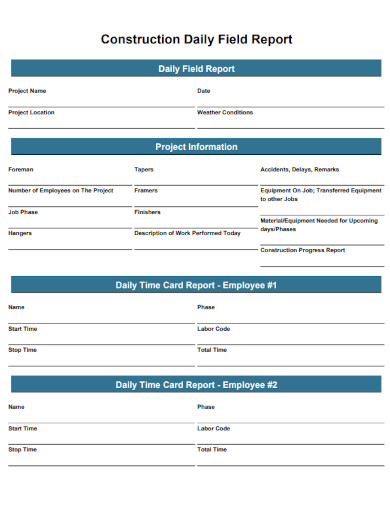
Construction Daily Field Report
download now -
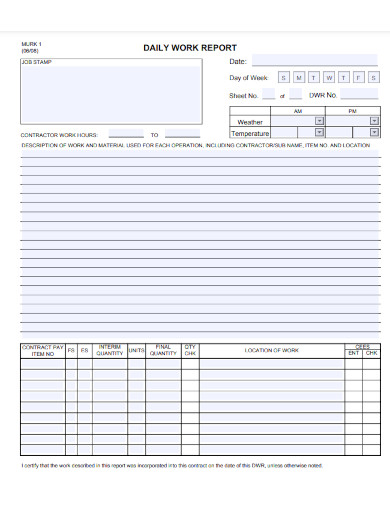
Construction Daily Work Report
download now
What is a Construction Daily Report?
A Construction Daily Report, also known as a Daily Sheet Log or Construction Daily Diary, is a crucial document used in the construction industry to record and track the day-to-day activities on a construction site. It serves as a detailed record of all activities, events, and incidents that occur during the course of a construction project. This report typically includes information such as the weather conditions, work completed, materials used, equipment and manpower on-site, safety observations, and any issues or delays encountered.
Construction Daily Reports play a vital role in project management and communication, providing a clear overview of the project’s progress, facilitating accountability, and assisting in decision-making. They are essential for documenting construction projects, ensuring compliance, and addressing any disputes or claims that may arise in the future.
How do I prepare a Construction Report Daily?
Preparing a Construction Daily Report involves several key steps to ensure an accurate and comprehensive record of daily activities on the construction site. Here’s a step-by-step guide to help you create an effective daily report:
Gather Information: Begin by collecting essential information, such as the date, project name, location, and the names of the project manager and site personnel.
Weather Conditions: Record the weather conditions for the day, including temperature, precipitation, wind speed, and any other relevant information.
Work Log: Document all sample work activities carried out during the day. Include details like the type of work, tasks completed, and the location on the site.
Materials Used: List the materials used, including quantities, delivery details, and any issues related to materials.
Manpower and Equipment: Provide a list of all personnel on-site, their roles, and the equipment or machinery in use. Note any equipment issues or maintenance.
Safety Observations: Report any safety observations, incidents, or near misses. Ensure you document any corrective actions taken.
Delays and Issues: Record any delays, problems, or issues encountered during the day. Include details about the causes and potential solutions.
Progress Photos: Attach photographs of the site’s progress and any noteworthy developments. Visual documentation is valuable for reference.
Visitor Log: If there were any visitors or stakeholders on-site, sample document their names, affiliations, and the purpose of their visit.
Signatures: Include a space for the project manager and other relevant personnel to sign off on the report, indicating its accuracy and completeness.
Review and Proofread: Before finalizing the report, review it for accuracy and clarity. Ensure all information is organized and easy to understand.
Save and Distribute: Save the completed report in a secure location. Distribute it to all stakeholders, such as project managers, contractors, and relevant team members.
Digital Tools: Consider using construction management software or apps to streamline the reporting process and improve accessibility.
Consistency: Ensure that you maintain consistency in your reporting format and terminology throughout the project.
By following these steps, you can create a well-structured and informative Construction Daily Report that helps track project progress, address issues promptly, and maintain clear communication among project stakeholders.
You May Also See SAMPLE Construction Audit Report, SAMPLE Monthly Construction Report .
Tips for Effective Writing Construction Daily Report?
Writing an effective Construction Daily Report is crucial for documenting project progress and facilitating communication among project stakeholders. Here are some tips to help you write an effective report:
Be Consistent: Use a consistent format and structure for your daily analysis reports. This makes it easier for readers to quickly locate and understand the information they need.
Use Clear and Concise Language: Write in a clear, concise, and straightforward manner. Avoid jargon or overly technical language that might be unclear to some readers.
Include Relevant Details: Ensure that you include all pertinent details about the day’s activities, including work done, materials used, manpower, equipment, and any safety incidents or delays.
Use Bullet Points or Lists: Use bullet points or numbered lists to make information more scannable and easier to digest. This helps readers quickly identify key points.
Document Safety Observations: Pay special attention to safety observations, near misses, and incidents. Describe these in detail and outline any corrective actions taken.
Attach Photos: Visual documentation can be highly informative. Include photos with captions to illustrate progress, issues, or noteworthy developments on the construction site.
Highlight Delays and Issues: Clearly identify any delays, problems, or issues encountered during the day. Provide information on the causes and proposed or implemented solutions.
Organize Work Log: When detailing the day’s work activities, organize them in a logical sequence. Start with the most important or critical tasks and work down to less significant activities.
Use Time Stamps: If applicable, include time stamps for significant events or milestones. This helps in tracking the sequence of events throughout the day.
Be Objective: Avoid inserting personal opinions or emotions into the report. Stick to the facts and objective descriptions.
Proofread: Always proofread your report for spelling and grammatical errors. Errors can make the report less credible and professional.
Include Signatures: Ensure that the report is signed by relevant personnel, including the project manager or site supervisor, to verify its accuracy.
Digital Tools: Consider using construction management software or apps to streamline the reporting process. These tools often have templates and features for easy report generation.
Archive Reports: Keep a record of all daily reports in an organized manner, either electronically or in a physical archive. This can be valuable for future reference and auditing.
Regularly Update Stakeholders: Communicate with relevant stakeholders about the report’s availability and any critical information contained in it.
Learn from Past Reports: Use previous reports as a reference to improve your reporting process. If recurring issues are identified, take steps to address them.
Seek Feedback: Encourage feedback from team members and stakeholders to identify areas for improvement in your reporting.
An effective Construction Daily Report provides a comprehensive overview of daily activities, helps with problem-solving, and serves as a valuable historical record for construction projects. Following these tips will contribute to the quality and usefulness of your reports.
You May Also See SAMPLE Construction Inspection Report, SAMPLE Construction Business Report In PDF.
A Complete Guide a Construction Daily Report
Creating a comprehensive Construction Daily Report is essential for documenting daily activities on a construction site. This guide will help you understand the key components and best practices for preparing such a report.
Heading and Identification: Start with a clear heading that includes the project name, site location, date, and the name of the person or team responsible for the report.
Weather Conditions: Begin with a section describing the weather conditions for the day, including temperature, precipitation, wind speed, and any significant weather-related factors.
Work Log: Provide a detailed log of all work activities carried out during the day. Include the type of work, specific tasks completed, and the location within the construction site where the work occurred.
Materials Used: List the materials used during the day, including quantities, delivery information, and any material-related issues, such as shortages or defects.
Manpower and Equipment: Document the personnel on-site, their roles, and any changes in the workforce. Include information about equipment and machinery in use, as well as any equipment-related issues or maintenance.
Safety Observations: Report any safety observations, incidents, near misses, or safety concerns that occurred during the day. Describe these in detail and note any corrective actions taken.
Delays and Issues: Clearly identify and describe any delays, problems, or issues encountered during the day. Explain the causes and propose or describe implemented solutions.
Progress Photos: Include photographs or images of the construction site to visually document the day’s progress and any significant developments. Add captions or descriptions for context.
Visitor Log: Document any visitors or stakeholders who were on-site, including their names, affiliations, and the purpose of their visit. Note any discussions or decisions made during these visits.
Signatures: – Include spaces for the project manager and other relevant personnel to sign off on the report, confirming its accuracy and completeness.
Review and Proofread: – Before finalizing the report, review it for accuracy, clarity, and completeness. Ensure that all information is well-organized and easy to understand.
Save and Distribute: – Save the completed report in a secure location, either electronically or in a physical archive. Distribute it to all relevant stakeholders, including project managers, contractors, and team members.
Consistency: – Maintain a consistent format and terminology for your daily reports throughout the project to ensure easy reference and tracking.
Use Digital Tools: – Consider using construction management software or apps designed for daily reporting. These tools often provide templates and features to streamline the reporting process.
Learn and Improve: – Use past reports as references to improve your reporting process. Address recurring issues or inefficiencies identified in previous reports.
A well-structured and informative Construction Daily Report is essential for effective project management, communication, and documentation. It provides a valuable record of project progress report and serves as a reference for decision-making and dispute resolution.
What is Daily Progress Report in Construction?
A daily progress report in construction is a concise document that records the key activities, achievements, challenges, and developments on a construction site for a specific day. It provides a snapshot of the project’s daily status and serves as a crucial communication and documentation tool.
You May Also See SAMPLE Subcontractor Daily Report In PDF, SAMPLE Daily Construction Schedule In MS Word
What is a Construction Project Daily Report
A construction project daily report is a brief document that summarizes the essential activities, events, and observations on a construction site for a single day. It helps track progress, issues, and safety incidents while providing a historical record of daily work.
The conclusion for a Construction Daily Report typically summarizes the day’s activities, progress, challenges, and any notable events. It serves as a concise overview of the construction project Report status and may include key takeaways or plans for the next day.
You May Also See SAMPLE Daily Construction Report,
